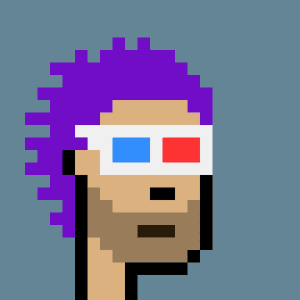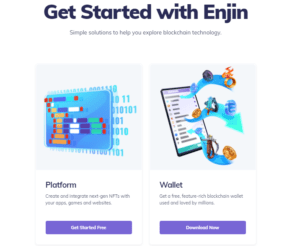Top 8 NFT projects revolutionizing the crypto space
What are NFTs?
The abbreviation NFT stands for non-fungible token. In a nutshell, NFTs are unique blockchain assets digitally representing physical assets or other digital assets. NFTs use blockchain technology to record all information about a digital work of art and related transactions. NFTs can be made of just about anything you can imagine – the options are limitless.
For example, there are NFTs of animated GIFS, digital paintings, digitisation of physical paintings, music, videos, or even tweets traded as NFT.
Blockchain technology makes it almost impossible to counterfeit a digital work of art. This makes NFTs the ultimate certificate of authenticity and highly interesting for collectors. For us to understand what non-fungible tokens are, we must first understand the concept of fungibility.
Fungibility
When an asset is fungible, it means that you can interchange it with another object in its asset without any loss of value, as was the case with barter trade. You can replace a $100 note with another $100 note, and there will be no change in value. More so, you can break down the $100 into smaller denominations, and you would remain with money worth $100. The same goes for cryptocurrencies too – you can subdivide BTC to the smallest unit – 1 Satoshi. They can be subdivided into smaller units and spent independently of each other.
Note that fungibility is relative. That means that it is only applicable when we are comparing multiple assets. Let's take the example of plane tickets – you have business class, economy class, and first-class flight tickets. These tickets are fungible within the specified classes since you cannot justly exchange a first-class ticket for an economy-class ticket without losing some value.
However, the concept of fungibility can also be subjective. In the above example, if someone prefers sitting by the window, they will attach more value to their ticket than, say, one which allows them to sit by the aisle. The same can be said about money as well. If you have a 1 cent coin, it is worth just 1 cent to you. But to a coin collector, it might be worth a lot more than just 1 cent. NFTs do not have these qualities.
NFTs as an Investment
Just like physical artwork, NFTs typically do not generate immediate returns but can be held as investments, considering the potential resale value. The sale to the highest bidder can enable gigantic profits due to the scarcity of supply. However, one should not be blinded by this prospect, because as with all asset classes, there is no guarantee that your NFT's value will appreciate. The market for NFTs is still nascent, making price discovery highly inefficient. There is currently a lack of a history of transactions that provides clues for evaluating digital works of art.
On the other hand, the barriers to entry to investing are lower than for physical works of art. Participation is also possible for smaller projects. It is also noteworthy that the non-fungibility discussed also refers to NFTs as an investment class: Unlike stocks or other securities, with a liquid market and daily pricing, the value of an NFT can only be determined by actually being offered for sale. NFTs are highly speculative and may turn out to be dud investments.
NFT's: A Brief History
Although NFTs have gained massive mainstream popularity during the first quarter of 2021, their origin date back to 2012. The first studies and experiments in NFTs began with the emergence of “coloured coins” in the Bitcoin network back in 2012.
Coloured Coins consist of the small values of a BTC, often as small as 1 Satoshi. Coloured Coins can be used to represent a large number of assets and can have multiple use cases, including real estate, Coupons, company shares, subscriptions, or digital collections. This opened the door to NFTs by showing the enormous potential of digitising physical assets.
Although CryptoPunks and CryptoKitties are regarded as some of the most popular NFTs today, Rare Pepes illustrates Pepe the Frog's character, built on the “Bitcoin counterparty” system first true NFTs in the market. Some of them were sold on eBay, and some later sold at a live auction.
The first Ethereum-based NFT experiment was CryptoPunks, a series of 10,000 unique collections, each with a range of “unique” features. CryptoPunks, developed by Larva Labs, had an on-chain market that could be used with wallets such as MetaMask, reducing the entry barrier to interacting with NFT.
The Top NFT Projects
-
CryptoKitties
It is impossible not to talk about CryptoKitties because this was the first use of NFT to hit the mainstream media. CryptoKitties are a brainchild of Dapper Labs. Its concept is closely linked to Pokémon Go. Instead of collecting Pokémon, each with unique features, you can collect digital crypto cats that come with certain features. By breeding cats, you can create new cats and thus discover new features.
-
CryptoPunks
CryptoPunks is one of the oldest NFT projects launched by Larva Labs in June 2017. This project features 10,000 unique collectable characters with proof of ownership stored on the Ethereum blockchain.
-
NBA Top Shot
NBA Top Shot, is one of the most successful NFT projects in March 2021, is also developed by Dapper Labs. It is undoubtedly one of the most popular platforms for NFT's based on the FLOW blockchain. Thanks to this NFT project, different moments from various NBA games are captured and converted into NFTs. The most common packages received in the NBA Top Shot project include 10000 or more cards. Rare packages are included in the card between 150-4999. Legendary packages are also limited to 25-499.
Top NFT Marketplaces
The Flow NFT project is a developer-friendly blockchain that serves as a foundation for a new generation of decentralised game apps and digital assets. Although it is a layer-one blockchain, it is backed by a team of blockchain experts behind some of the biggest names in NFT and consumer blockchain applications such as CryptoKitties Dapper Wallet and the NBA Top Shot.
As of this publication, Flow had a market cap of about $590.3 million.
Enjin is one of the leading companies that offer an ecosystem for several digital products, making it relatively easy for anyone to monetise gaming products. That means that game developers can tokenise in-game items via Ethereum – backed by Enjin's ERC 20 token. Enjin coin is one of the cheapest altcoins in the market – $2.5 as of this writing – and offers investors the highest growth potential among altcoins.
As of this publication, Enjin had a market capitalisation of over $1.36 billion
MANA is built upon Ethereum, and it allows users to create, experience, and monetise content and applications. With MANA, they can purchase virtual property to navigate through, develop and monetise however they want.
As of June 2021, MANA had a market capitalisation of over $1.35 billion. It was launched in February 2020 with an ICO worth $24 million. The platform utilises one ERC-20 (MANA) and one ERC-721 (LAND) token. To acquire property, MANA must be burned.
-
Axie Infinity (AXS)
Pokémon-inspired Axie Infinity. It is a trading and battling game platform that allows users to monetise battle creatures called Axies. They can collect them, breed and trade them. The unique thing about the platform is that it is partially owned and managed by the players. To participate in voting, the players must use the Axie Infinite Shards (AXS) ERC-20 token.
Note that the Axies can be customised into various forms, with some taking up more than 500 body parts. They can also reproduce up to 7 Axies which users can sell at the marketplace. As of June 2021, Axie Infinity had a market capitalisation of over $302.3 million. It was released on November 4, 2020.
Gods Unchained has created a collectable card game where cards are given as NFT. Therefore, since ownership of cards can be digitally transferred, you can solve all the above problems and verify the authenticity of each card. Moreover, you can quickly change the ownership of cards through a simple Ethereum process.
OpenSea market allows any NFT to be auctioned on the platform. It is a decentralised marketplace where trading takes place under a smart contract
-
Terra Virtua Kolect (TVK)
TVK is a crypto marketplace for NFTs that accommodates both creators and collectors in one ecosystem. It was launched on January 20, 2019, in partnership with established media companies like Legendary Entertainment and Paramount Pictures and raised about $2.6 million in an ICO.
As of June 2021, it had a market capitalisation of about $47.3 million.
-
Origin Protocol (OGN)
This is a decentralised marketplace and is often known as DShop in the NFT crypto world. It hosted the first-ever auction for a tokenised musical note album by 3LAU – a renowned musician for over $344.2 million.
Uses of NFTs
We mentioned that you could create NFTs of just about anything – physical or digital. Here are some of the top areas where NFTs are applied:
-
Online Gaming
One of the sectors that NFTs are revolutionising is the world of gaming. The sale of rare weapons or skins is currently prohibited in popular games such as World of Warcraft, Fortnite, CS:GO, or League of Legends. NFTs are used to make these assets tradeable for real-world cash or in-game tokens. Good examples of NFT projects in this space are Decentraland, Sorare¸ and Gods Unchained.
-
Rare Collectibles
As you've seen with the CryptoKitties, the Fantasy Football Game Sorare or NBA Top Shot from Dapper Labs, NFTs are already being used to create completely new types of rare collectables. Sorare, for example, allows you to purchase tokenised versions of your favourite players.
-
Music and Art
It is often a nightmare for artists to protect their copyrights and make money in the digital world. Through NFTs, someone can buy a work of art and present it in a virtual space, with the blockchain proving ownership. Artists can thus protect their copyright and secure a larger share of the profits generated by the sale. This has led to a surge in the number of artists issuing NFTs.
How to Create an NFT?
There are many platforms for storing and auctioning concrete objects in the real world in an abstract digital environment. In the future, we expect that the number of these platforms will increase exponentially. However, you do not need to be a crypto programmer to create an NFT.
NFTs are typically built on Ethereum as ERC-721, which has a set of standard features and attributes that define it in the form of a smart contract. Simply put, the ERC-721 provides us with a standard for creating and exchanging NFTs.
Today, you can create your own NFT in minutes through many NFT platforms such as Enjin. You simply sign up for the platform and start creating your digital artworks by downloading the Enjin wallet. Here's how to create your own NFT.
There is also the option to download digital wallets for iOS and Android on the platform, allowing you to create the NFT individually or as a team.
- Click on the “Create Asset” button.
- Download the Wallet app – depending on your device's OS.
- After you save and verify your seed wallet words through the app, you should refresh the page. After doing this, the account created through the cloud with the “Enjin Wallet App” can work simultaneously with each other.
- Finally, after entering the “metadata” of the digital asset, you should click on the “Create Asset” button.
Congratulations, you now have an NFT, and you can both view your assets through the app and track your assets through the web platform.
There are options where you can determine the name, asset type (whether it is Fungible or Non-Fungible), whether the total supply amount is fixed, the amount of value for each asset, whether there will be a commission fee, and how much commission the creator will receive from each sale after the first sale.
Trading NFTs can be difficult due to the lack of liquidity. So while you can hit it big, getting consistent profits is more of a challenge. If you're looking for trading signals and guidance from a professional team, try out our free telegram signals group.






